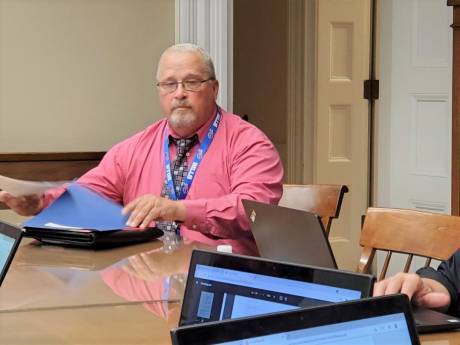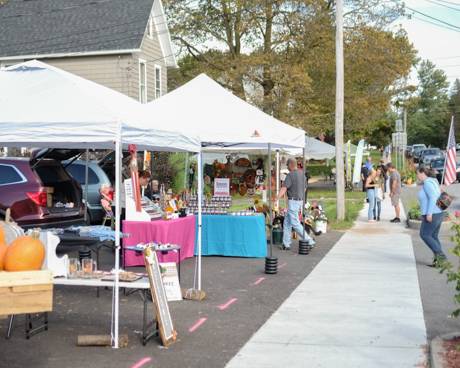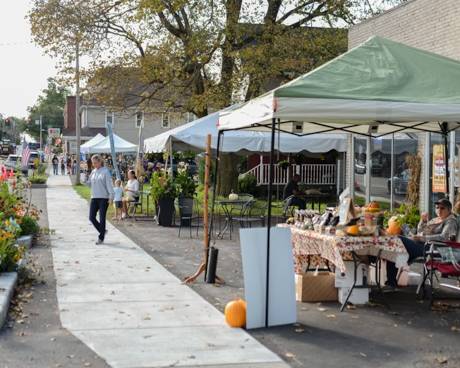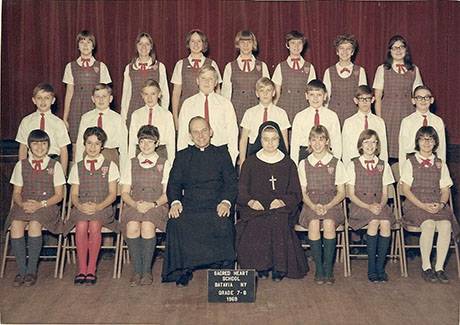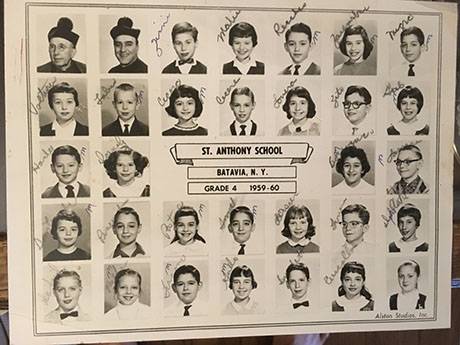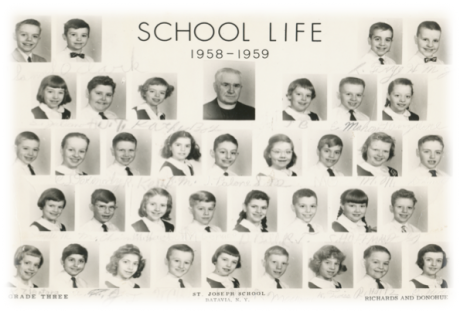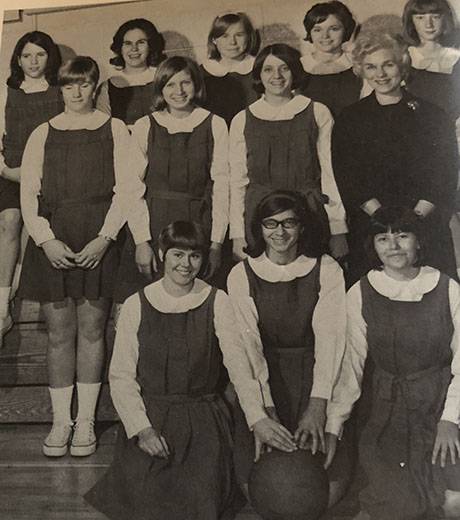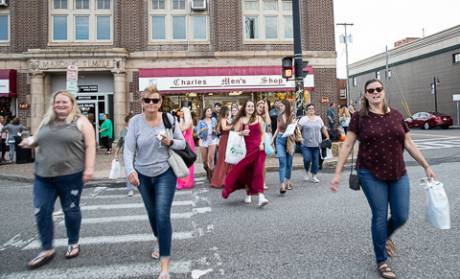The Batavia businessman proposing the development of a 60-unit senior housing complex and eight single-family home building lots in the Village of Le Roy on Monday night offered to pay the lion’s share of the cost to extend East Avenue to make room for those lots.
Toward the end of what turned into a 2 hour and 43 minute public hearing at Memorial Auditorium, Eric Biscaro addressed the need to extend the road – something that Village Mayor Greg Rogers previously had said the village would consider doing.
About 50 people, most of them residents of the East Avenue, Poplar Lane and Orchard Drive area, attended.
Biscaro said he could extend East Avenue by about 1,000 feet to the south for considerably less than the $1 million estimate the village had received, comparing the work to the road he put in at his Clinton Crossings Adult Community development in the Town of Batavia.
Holding a photograph of the road (pictured above), Biscaro said, “The road is perfect and that was put in 15 years ago.”
He pitched the idea of the village contributing $26,000 for stone and gravel plus the time involved in trucking the material toward the construction of the road, which he said would be 24 feet wide. It would extend south to a point where an access road or emergency exit could be carved out on South Avenue, connecting to South Street.
The village board did not make any commitments last night and tabled a couple resolutions on the State Environmental Quality Review that is part of the requirements before the project can progress.
When asked about the village’s stance on paying for the East Avenue extension, Rogers said that news of a potential Payment in Lieu of Taxes agreement between Biscaro and the Genesee County Economic Development Center changes things.
“(With the PILOT) our recapture (of taxes) is a lot less now,” Rogers said. “That one million (dollars) is not on the table at this point.”
Rogers said that no voting on the project – including the rezoning of the 20-acre parcel to the east of East Avenue designated for the senior housing complex – would take place until an agreement on the road extension is reached.
After Biscaro said that “the project can be done without the road,” Rogers countered by restating the village’s position that it wants single-family homes (as well as the rental properties for those 50 and over).
Mark Masse, GCEDC vice president of operations, spoke first at the public hearing to give details about Biscaro’s application for incentives.
He also reported that the county has a need for 1,400 new single-family homes and market rate apartments over the next 20 years “to keep up with the (projected) growth.”
Concerning the tax abatements, Masse said the project qualifies for sales tax (materials) and mortgage tax breaks as well as a PILOT, which would reduce Biscaro’s tax bill on a sliding scale over 20 years.
Specifically, Masse said, Biscaro would be responsible for 10 percent of total taxes (county, village and school) for the first four years, 15 percent for the next three years, 20 percent for the next three years, 50 percent for the next five years and 75 percent for the final five years. The PILOT does not cover taxes and fees for any special districts, such as water and sewer.
When a resident mentioned that the village would be losing out on tax revenue, Masse said completion of the project would bring in more than what the village is receiving now on the vacant land. He also noted that tenants would pay their own water and sewer bills.
Masse said the GCEDC has approved incentives for similar projects, mentioning The Manor House and DePaul Properties in Batavia, with a difference being that those projects did not have to be rezoned.
The Village Board would have to approve rezoning of the land earmarked for the senior apartments from Residential to Planned Unit Development. The single-family home building lots on East Avenue would continue to be zoned Residential, however, Rogers said.
Residents asked questions and offered opinions on several other pressing issues, most notably the project’s impact on traffic, stormwater runoff, property values, tax implications and housing opportunities – basically the same concerns that were expressed during a public hearing on Aug. 18 at Memorial Auditorium.
TRAFFIC IMPLICATIONS
Andrew Kosa, engineer with CPL (Clark Patterson Lee), reported that by using numbers provided through a traffic study conducted by the Le Roy Police Department, that the project would result in twice the number of vehicles on East Avenue and East Main Street during peak morning and afternoon times.
Still, Kosa said, that would not significantly impact traffic flow, stating that East Avenue traffic would continue to be at a satisfactory level.
This prompted a resident to bring up the “dangerous” situation where motorists are unable to see clearly as they move from East Avenue onto East Main Street, and asked if the Village Board could look into this.
STORMWATER RETENTION
A major topic of discussion, Kosa said CPL’s role “is to ensure compliance,” adding that any water discharge from the project has to be equal or less than what is running off now.
Biscaro’s plan includes a retention pond in the northwest quadrant of the 30-duplex layout (see photo below).
LeRoyan James Gomborone, who owns nearby Mercy Grove and Le Roy Country Club, said his property gets considerable runoff now – and frequent flooding when it rains heavily – and said he wasn’t convinced of the stormwater plan’s effectiveness.
Biscaro responded by saying the water will flow to the north “and be considerably less than it is now or the same when it leaves the property.”
“My responsibility (under the law) is for it to come out the same or less (than it is now),” he said.
Kosa also responded to a question about the East Avenue extension, noting that CPL would have to mitigate any water issues or be subject to being fined by the Department of Environmental Conservation.
Biscaro reported that only 18 percent of the 20-acre apartment complex would be comprised of impervious cover, such as pavement, roofing, etc.
It was mentioned that Biscaro would be open to developing additional building lots on the west side of East Avenue. If so, a separate stormwater plan would have to be devised.
ZONING CHANGE
Resident Tom Condidorio contended that any zoning changes would affect home values, and called out the village board for not listening to its taxpayers.
Rogers responded by saying the overarching plan is to “try to grow the tax base so your property values don’t go down.”
It then was mentioned that another resident put in a retention pond in a different part of the village with duplexes and the average sale of homes in that area increased by 28 percent over assessed values.
TAX IMPLICATIONS
Biscaro read from a spreadsheet that breaks down the tax revenue starting with 2022 and going out to 2047.
He said the village is collecting $400 a year and the Le Roy Central School District is collecting $960 a year on the property as it currently stands, but each entity would collect six times that amount in the first year.
In year 10, with the completion of the apartment complex and new home builds, he said the village would receive $61,500 in tax revenue and Le Roy Central School District would earn $147,600.
All told, Biscaro’s projections show the village receiving $1.5 million in taxes and the school district capturing $3.7 million in taxes over the 25 years.
HOUSING OPPORTUNITIES
A LeRoyan said she was in favor of creating residences for those people 50 and over, noting that “Le Roy residents have no place to go.”
She said her father is 76 and “this would be the perfect place for him.”
“This is designed to be for rentals,” she said. “Some people don’t want to own (their homes any longer).”
Biscaro, responding to calls for the project to be moved outside the village, said, “This is a fabulous location. We want to be in a good place.”
---------------
Moving forward, Rogers said the village board will evaluate Biscaro’s proposal to construct the road, with an eye on possibly making a decision at its Oct. 20 meeting.
Drawing of the 60-unit senior apartment complex, showing the oval-shaped retention pond at upper left, as well as the proposed extention of East Avenue along the left side with eight building lots.
Previously: East Avenue area residents defend their 'jewel' of a neighborhood at public hearing on Le Roy development


